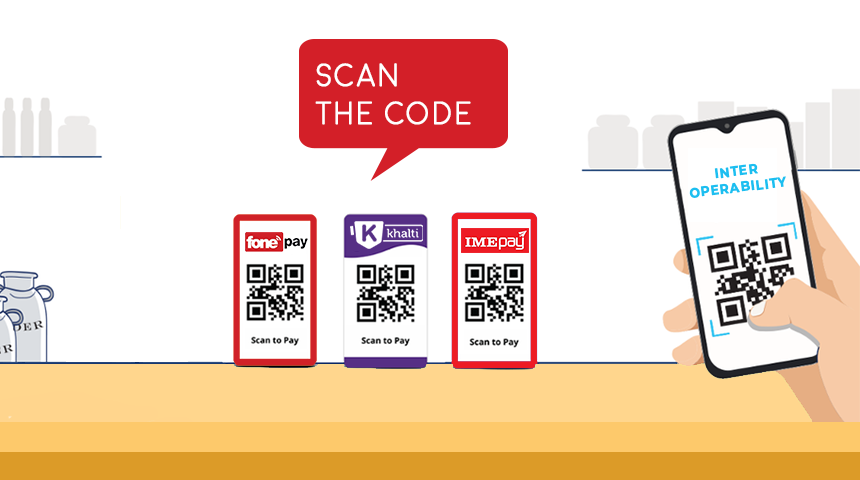The use of Quick Response Card has been growing rapidly all across Nepal. From supermarkets to local Kirana pasal (small groceries) and vegetable stalls and from high-end restaurants to Chiya pasal (small teashop), the merchants adopting QR code payment have been growing every day.

Nepal Rastra Bank has been implementing various ways to encourage the merchants to adopt QR code system. Recently, Governor Maha Prashad Adhikari has been launching the QR code system in vegetable markets, auto-rickshaws, temples, and other places.
NRB has also enforced QR Code guidelines ‘Nepal QR Standardization Framework and Guidelines’ to regulate the QR payment system in Nepal.
QR Code Payment System in Nepal
According to NRB, nine Payment Service Operators (PSOs) have received a license to operate QR code service. Similarly, 18 Payment Service Platforms (PSPs) and mobile wallets have got approval to offer QR code services.
Users’ perception
According to the users, QR codes is one of the most convenient forms of digital payment as it facilitates instant payment and is available in most places.
For QR code payment, the users have to open an app which they use for QR code payment, scan the code and confirm to process the payment.
Yogendra Shrestha usually prefers to transact through QR codes in restaurants and when he purchases online. “I normally use cards for payment. But QR code is a much easier alternative especially in cases where we cannot use cards and whenever there are technical issues while swiping a card,” he shares.
“The best part is that we can find QR platforms everywhere from small tea shops to big restaurants. So, I believe this technology will be quite helpful to go cashless,” opines Shrestha.
Similarly, Uttam Lama, merchant of Lotte Mart, Boudha says that 10 percent of the digital payment consists of QR code payment. “The payment system is easier than using a debit card. Sometimes the debit cards don’t work due to system and technical error, but I had never had such a problem in QR card scan,” he says.
Trend and transactions
The trend of using QR code payment has been increasing every day. The number of transactions has also been fuelled by the outbreak of the COVID 19 pandemic.
According to the report from NRB, the number of QR-based transactions in Poush 2077 (mid-December to mid-January) was 3, 72,176. Similarly, the transactional amount was Rs 1,245 million.
The number of QR code transactions has almost doubled than the transaction report of Shrawan 2077 (Mid-July to Mid-August). According to NRB, the number of transactions from Mid-July to Mid-August was 1, 95,016. And the amount of QR-based transactions for the same months was Rs 589 million.
According to Subash Sapkota, CEO of eSewa and director of F1 Soft International, there are 2,75,000 merchants who use QR Codes for payment all over Nepal. Among them, 75,000 merchants have been acquired by eSewa for Fonepay. Fonepay is a payment processing platform developed by F1 Soft, which has collaborated with more than 50 banks for QR Code payment through mobile banking.
NRB Guideline
NRB has enforced the guideline to regulate the players which are linked with the Quick Response (QR) code payment ecosystem. The guideline addresses the PSOs, PSPs, merchant, issuer, and customers.
Few of the provisions in the guidelines include eligibility criteria for merchants, issuers, and acquirers, risk, grievance handling from customers, information security, customer awareness, QR logo and branding, and interoperability compliance.
Opportunity and Challenges
QR Code system is a cost-effective system as this will allow the merchant to receive digital payment without using Point of Sales (POS) swiping machines.
The adoption rate seems interesting. Also, the government says that QR code payment is an inexpensive technology that can help to bring all the informal sectors into the formal economy.
“QR is emerging as the preferred mode of payments amongst consumers and merchants equally. Wallets are largely responsible for popularizing mobile payments across the globe and have greatly influenced the consumer’s behavior to scan QR for payments,” writes the NepalQR Standardization Framework and Guidelines.
Nevertheless, to move to its full potential, Nepal needs to develop infrastructure and educate the merchants and users to expand the user base of QR code payment.
One of the main challenges is interoperability. At present, the user needs to download the app developed by the company that designed the QR code. The user has to download multiple apps to use QR code payment in different places.
“This happens to me when I pay for the fuel. I usually prefer digital payments. But as the petrol pump uses IME Pay QR Code and I use e-Sewa. I usually have to pay cash for fuel,” says consumer Shrestha.
“As the payment ecosystem matures and the number of payment system operators/ providers proliferate there is an increasing threat of an imbalance. It, therefore, becomes necessary to develop standards to bring in uniformity and provide equal opportunity for all players in the payment space. This standard provisions for three major payment principles – Interoperability, Scalability, and Security,” writes the guideline.
Bhuban Kadel, Sr. executive director, NRB says that the QR Code payment system will fail if there is no interoperability. “Also, QR code companies will not be able to make their product viable and scalable if the system is not interoperable,” Kadel shares.
NRB has authorized Nepal Clearing House Limited (NCHL) to prepare a national payment switch. NCHL started the feasibility study in mid-2020 and now is in the initial stage of studying the modality of the switch.
“We are in the initial stage now and have not set any timeline for the completion,” says Neelesh Man Singh Pradhan, CEO of NCHL.
Agarwal from Khalti urges the need for a payment switch as soon as possible. “Technology is dynamic and we need to move quickly to make optimum use of the benefit it provides. We need to set a timeline and come up with a solution quickly,” says Agarwal.
Khalti has just started acquiring merchants for QR Code payment. “We are in the testing phase and we will start putting QRs aggressively from Baisakh (Mid-April),” he says.
Agarwal adds that Khalti has been waiting for an interoperability policy from NRB. “We hope that interoperability policy will be implemented from the next fiscal year,” says Agarwal.
Also, the merchant must have a PAN card and bank account to acquire QR Code payment. This will be an opportunity to formalize the informal sectors and it can be achieved with a significant amount of effort. “This needs massive awareness campaigns,” says Agarwal.
ALSO READ: Why is the Internet So Costly in Nepal? The Short Answer is “Exorbitant Taxes!”
Future
Replacing digital payment with cash, which is now a primary form of transaction will take time. But, the consumer’s approach towards e-payment has been changing recently. Once reluctant to pay digitally before COVID, many consumers have become used to swiping cards, paying through wallets, and QR payment.
Merchant Lama says that still, 90 percent of the customers prefer to pay from cash.
“Cash is still the king. But the number of queries regarding QR Pay Scan is growing rapidly,” says Lama from Boudha.
Similarly, Sapkota from F1 Soft says that only a few merchants have implemented the QR Code platform.
“There are around 30, 00,000 merchants all over Nepal. QR Code platform has reached only 10 percent of the merchant,” Sapkota says.
“To adapt to a cashless system, around 70-80 percent of merchants should use this platform. Only then, the customers will go for digital payment as their primary choice,” he observes.
He shares that e-Sewa has been providing all the QR Code payment services for free and they have not been charging any transaction fee to the merchant. “We are still in a nascent phase, where merchants are hesitant to use this platform. We are encouraging more people to use this platform,” says Sapkota.
Agarwal from Khalti aligns with the thought of Sapkota. “There is no service fee when transacting from Khalti. First, we need to aware of people and expand the user base,” he says. If we want to go cashless, people should not have any option other than digital payment, he opines. This will again take a lot of effort, in terms of digital payment education.
Sapkota views that the number of users will increase rapidly in the coming years. Around 64.65 percent of the total population of Nepal is from the 15-64 years age group. “This is a financially active age group and this group gets access to the information about digital payment through different mediums including social media,” he says.
Sapkota further adds that with the active engagement of NRB in terms of policy and awareness, the digital payment market will see a lot of positive changes in around two years.
READ NEXT: Draft e-Commerce Bill: Major Highlights and Issues Raised by the Stakeholders
-
TechLekh Awards: Best Cars of 2025 in Nepal Winners!Electric vehicles continue to dominate Nepal’s market in 2025, and Chinese manufacturers still lead the…
-
Best Phones Under 20000 in Nepal (January 2026 Updated)Getting a smartphone under Rs. 20,000 can be quite nerve-wracking. For many of us, it…
-
Yamaha Bike Price in Nepal (January 2026 Updated)This is the complete list of Yamaha bike price in Nepal for 2026. In this…
-
Suzuki Bike Price in Nepal (January 2026 Updated)This is the complete list of Suzuki bike price in Nepal for 2026. In this…















